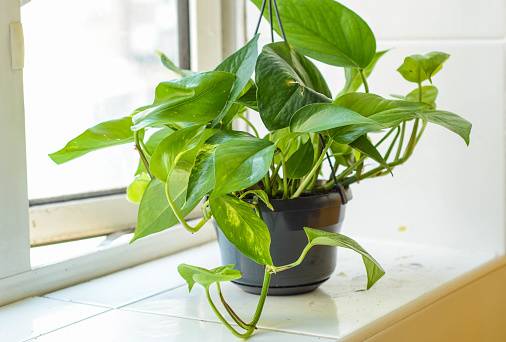How to Save Overwatered Pothos (Devil’s Ivy)
Hey folks, welcome back! we are here with another informative topic that will help you in your gardening field. You might have heard of the amazing plant named Pothos. Pothos is one of the most popular houseplants and for good reason. One of the issues I faced in my gardening career was that Pothos began to become overwatered and I become tense. But then I came up with some ideas to save them which I have shared in this guide.
Key takeaways:
- Pothos plants are easy to care for, tough to kill, and very attractive.
- Overwatered pothos can be saved easily but you need to know about its reasons first.
- Some of them are the yellowing of the leaves, soggy soil, root rot, and brown spots on the leaves.
- Save overwatered pothos by reading the guide. However, even the most resilient plants can succumb to overwatering.
If you think your pothos is overwatered, don’t despair. There are a few things you can do to save it. In this blog post, we will explore how to save overwatered pothos (also known as devil’s ivy). From diagnosing the problem to taking corrective action, we will help you get your plant back on track. So, what are you waiting for? Let’s move forward to know in detail How to save overwatered pothos.
How to Save Overwatered Pothos? What are the signs of overwatering?
As mentioned overwatering is not a good sign for the plants as it makes them weak. But you need to know about some of the reasons behind this cause. If you know them, then try to save overwatered pothos, but if not, then read the below points:
Soggy Soil
If your pothos is wilting and the leaves are yellowing, you’re likely overwatering it. Soggy soil can lead to root rot, which will kill your plant.

If you think your pothos is overwatered, let the soil dry out completely before watering again. You can also add a drainage layer of gravel or rocks to the pot to help with drainage.
Yellowing Leaves
One of the most common problems with pothos plants is overwatering. This can cause the leaves to turn yellow and eventually drop off the plant. If you think you have overwatered your pothos, there are a few things you can do to save it.
First, stop watering the plant and allow the soil to dry out completely. Once the soil is dry, you can start watering again but be sure to water only when the soil is dry to the touch.
If the leaves are already yellow, you can try trimming them off. This will help the plant focus its energy on new growth.
Finally, make sure you are using a well-draining potting mix and that your pot has drainage holes. Over time, roots that are constantly wet will rot and this can kill your plant.
Browning of the Leaves
If your pothos plant has brown leaves, it is likely overwatered. Overwatering can cause the leaves to turn brown and drop off the plant. It can also lead to root rot, which can kill the plant.
To save overwatered pothos, you will need to take action immediately. First, stop watering the plant and allow the soil to dry out completely. Next, remove any affected leaves from the plant. Finally, repot the plant in fresh, well-draining potting mix.
Once you have taken these steps, be sure to water your pothos only when the top inch of soil is dry. This will help prevent overwatering in the future and you will be able to save overwatered pothos

Brown Spots on Leaves
When leaves develop brown spots, just like the Monstera plant it’s often a sign of too much water. Overwatered Pothos will have leaves that are yellowing and browning, and the leaves may be dropping off the plant. If you think your Pothos is overwatered, the first step is to check the soil.
If the soil is soggy or mushy, it’s time to let your plant dry out. Remove any affected leaves and allow the soil to dry out completely before watering again. Once the soil is dry, you can resume watering as usual.
Root Rot
Overwatered pothos often suffers from root rot, which can be difficult to treat. If you think your pothos has root rot, it’s important to take action quickly. The first step is to remove the plant from the pot and inspect the roots. If they are mushy or black, they are probably infected with root rot.
You will need to trim away any affected roots and repot the plant in fresh soil. Be sure to water it carefully, as overwatering is what caused the problem in the first place. You may also want to consider using a fungicide to prevent the root rot from returning.
Concluding lines
In this guide, you come to know that Pothos is one of the most popular houseplants, and for good reason. It’s easy to care for, tough to kill, and very attractive. Pothos are well known for their hardiness in their growing conditions. sometimes, they face issues like underwatering, overwatering, root rot, etc. It happens due to some factors and you need to know about the signs of the overwatering fo Pothos so that you find ways to save them. Read this guide as it will let you know about the tips that can help you in saving the overwatering pothos.
Thanks for reading! Happy gardening!
FAQ’s
How do you revive Overwatered Devils Ivy?
First, you need to determine if your Devil’s Ivy is truly overwatered. Check the leaves for signs of wilting, yellowing, or browning. If the leaves are soft to the touch or appear mushy, your plant is likely overwatered.
Once you have confirmed that your plant is overwatered, it’s time to take action to revive it. Start by carefully removing the plant from its pot. Gently shake off any excess water and roots from the root ball.
Next, repot the plant in a fresh potting mix and a clean pot. Be sure not to over-water your plant when you report it. Allow the soil to dry out completely between waterings.
Finally, place your plant in a bright spot out of direct sunlight and give it some time to recover. With proper care with light required, your Devil’s Ivy should be back to its healthy self in no time!
How can we save Underwater pothos?
Underwatering is one of the biggest problems when it comes to pothos care. too much water can quickly lead to root rot, and this can be fatal for your plant. If you think your pothos is overwatered, there are a few things you can do to try and save it from overwatering.
First, stop watering your plant immediately. Allow the soil to dry out completely before giving your pothos any more water. You may also want to consider repotting your plant into fresh, dry soil.
If the roots of your pothos are already rotting, you can try trimming them back to healthy tissue. Be sure to disinfect your scissors before and after trimming the affected roots.
Once you’ve taken these steps, continue to monitor your pothos carefully. Water only when the soil is completely dry, and don’t allow the roots to sit in water for extended periods. With a little patience and care, you should be able to nurse your overwatered pothos back to health!
Can an overwatered plant heal itself?
If you have overwatered your pothos, don’t despair! There are several things you can do to save your plant.
First, assess the damage. If the leaves are wilted and the stems are soft, the roots are likely waterlogged. This can be fatal to a plant, so it is important to take action quickly.
Next, stop watering the plant and let the soil dry out completely. This will give the roots a chance to recover from being waterlogged.
Once the soil is dry, you can start watering again, but be sure to water only when the soil is dry to the touch. Overwatering is easy to do, so it is important to be vigilant to avoid it in the future.
What to do if you accidentally overwatered a plant?
If you accidentally overwatered a plant, the first thing you need to do is stop watering it. Let the soil dry out completely before you water it again.
You can help the process along by gently removing the plant from its pot and letting the excess water drain away. Once the soil is dry, repot the plant in fresh, well-draining potting mix and water it as usual.
Will an overwatered pothos recover?
An overwatered pothos will not recover on its own. The leaves will become yellow and the plant will gradually die. However, you can save overwatered pothos by taking action immediately.
First, remove the plant from the pot and check the roots for rot. If the roots are soft or mushy, they need to be cut away. Use a sharp knife or pruning shears to remove the affected roots, then replant the pothos in fresh potting mix.
Next, water the pothos deeply but less frequently. Allow the soil to dry out completely between watering sessions. Pothos are tolerant of drought, so don’t be afraid to let them go a little bit dry.
Finally, give your pothos plenty of light. Pothos prefer bright, indirect light but can tolerate some direct sun. If your pothos is looking pale or leggy, it probably needs more light.
With proper care, overwatered pothos can be saved and will eventually recover.


